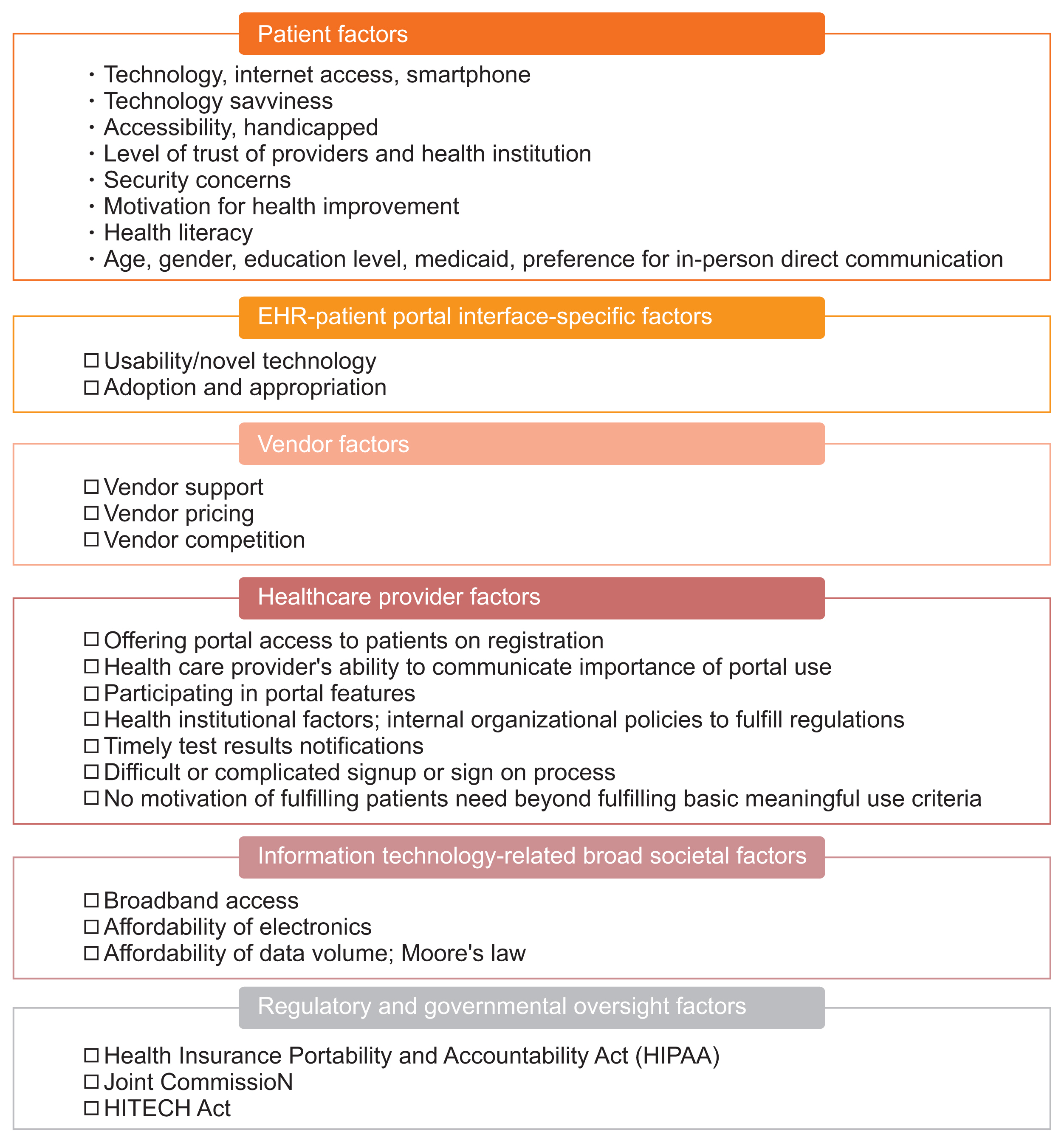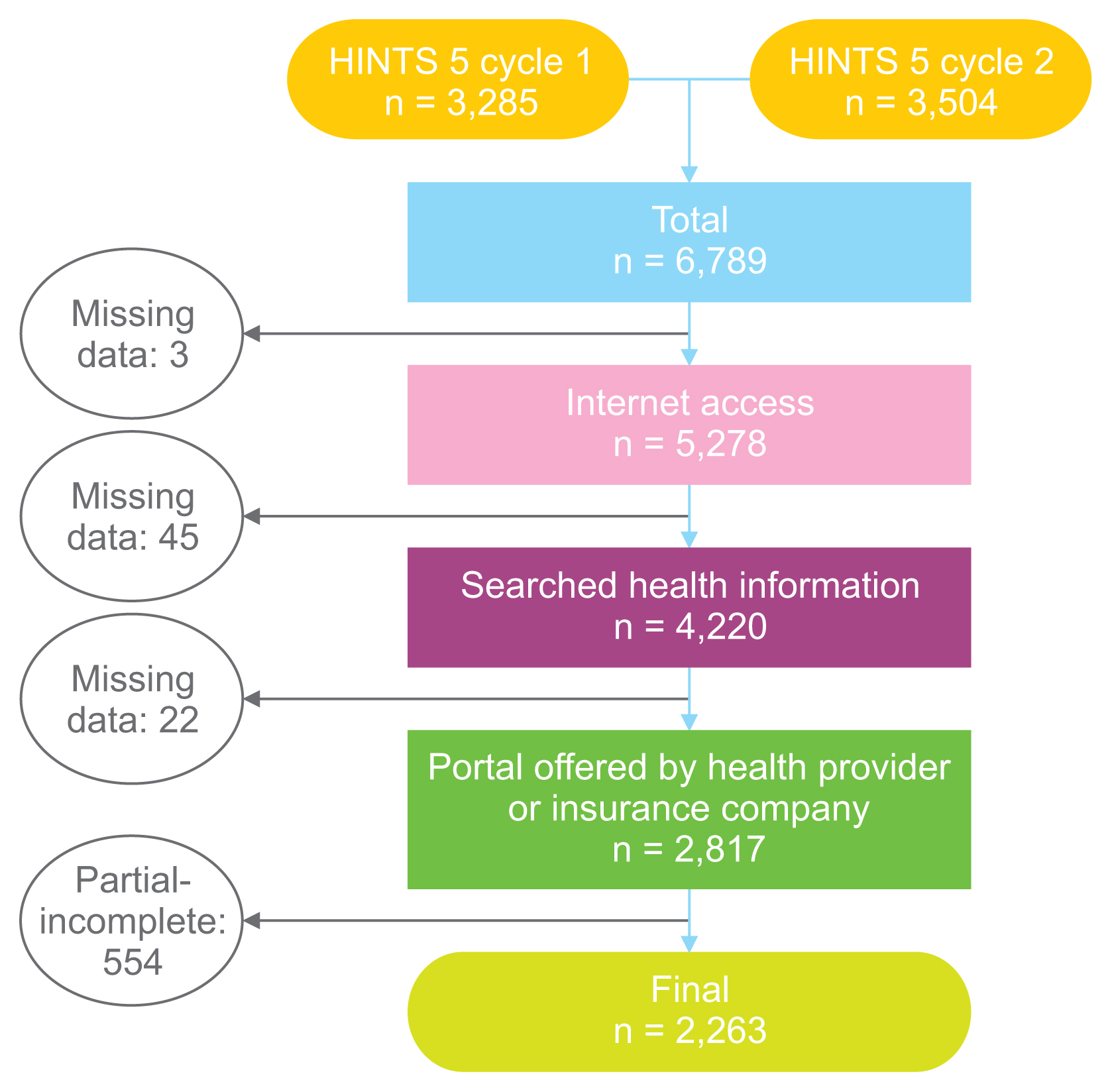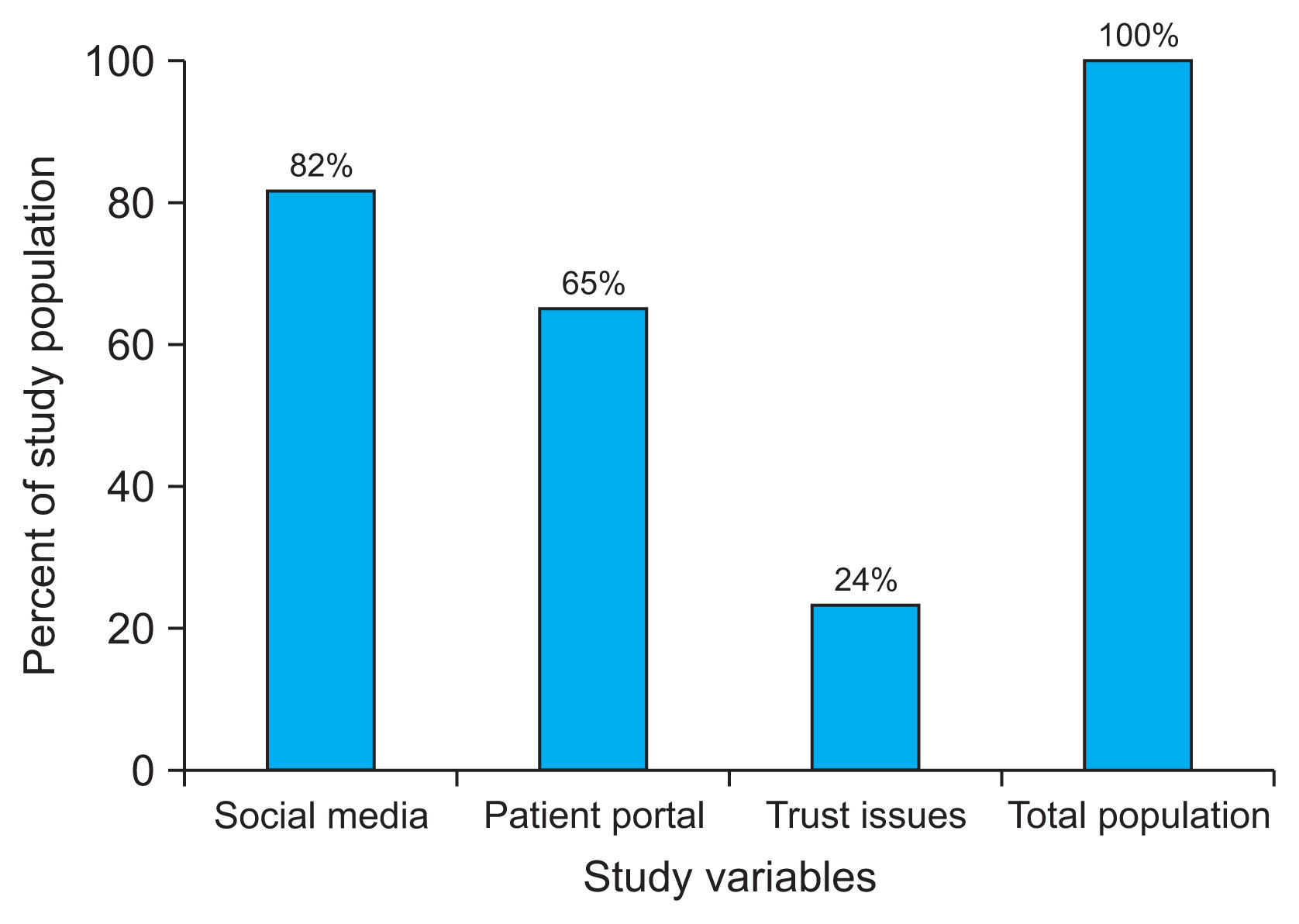Healthc Inform Res.
2020 Jul;26(3):220-228. 10.4258/hir.2020.26.3.220.
Impact of Digital Divide on the Adoption of Online Patient Portals for Self-Motivated Patients
- Affiliations
-
- 1Icahn School of Medicine at Mount Sinai, New York, NY, USA
- 2Senyaun Consulting, Brenham, TX, USA
- 3Geisinger Health Systems, Danville, PA, USA
- KMID: 2505263
- DOI: http://doi.org/10.4258/hir.2020.26.3.220
Abstract
Objectives
Our study aimed to determine the effect of the digital divide in the adoption of online patient portals by motivated patients who wish to improve their health outcomes through the use of the Internet and information technology to assess determinants of low adoption rates of online portals and to explore social media use as a correlation to patient portal use.
Methods
We utilized data from the Health Information National Trends Survey (HINTS) 2017 and 2018. We performed a cross-sectional study analyzing the outcome variable of patient portal use with several predictor variables, namely, age, marital status, gender, mental health, education, Medicaid, income, number of people in household, trust, social media, chronic disease, and health app use. Basic descriptive statistics and logistic regression were performed using SPSS version 25.
Results
Our study found that low adoption rates go beyond the digital divide. A correlation exists between social media use and patient portal use, and the impact of previously identified factors on patients with self-motivation for health improvement.
Conclusions
Self-motivation is an important factor in patient portal use and access. Behavioral and motivational interventions geared towards the adoption of health information technology tools, such as online portals, can assist with improving the public health significance of these tools.
Figure
Reference
-
References
1. The Office of the National Coordinator for Health Information Technology. What is a patient portal? [Internet]. Washington (DC): The Office of the National Coordinator for Health Information Technology;c2017. [cited at 2020 Jul 20]. Available from: https://www.healthit.gov/faq/what-patient-portal.2. Irizarry T, DeVito Dabbs A, Curran CR. Patient portals and patient engagement: a state of the science review. J Med Internet Res. 2015; 17(6):e148.
Article3. Hong YA, Jiang S, Liu PL. Use of patient portals of electronic health records remains low from 2014 to 2018: results from a national survey and policy implications. Am J Health Promot. 2020; 34(6):677–80.
Article4. Anthony DL, Campos-Castillo C, Lim PS. Who isn’t using patient portals and why? Evidence and implications from a national sample Of US Adults. Health Aff (Millwood). 2018; 37(12):1948–54.
Article5. Reed ME, Huang J, Brand RJ, Neugebauer R, Graetz I, Hsu J, et al. Patients with complex chronic conditions: Health care use and clinical events associated with access to a patient portal. PLoS One. 2019; 14(6):e0217636.
Article6. World Health Organization. Patient engagement: technical series on safer primary care [Internet]. Geneva, Switzerland: World Health Organization;2016. [cited at 2020 Jul 20]. Available from: https://apps.who.int/iris/bitstream/handle/10665/252269/9789241511629-eng.pdf;jsessionid=8627327055C471F934B5FA87EEDE3E44?sequence=1.7. Graetz I, Huang J, Muelly ER, Fireman B, Hsu J, Reed ME. Association of mobile patient portal access with diabetes medication adherence and glycemic levels among adults with diabetes. JAMA Netw Open. 2020; 3(2):e1921429.
Article8. Otte-Trojel T, de Bont A, van de Klundert J, Rundall TG. Characteristics of patient portals developed in the context of health information exchanges: early policy effects of incentives in the meaningful use program in the United States. J Med Internet Res. 2014; 16(11):e258.
Article9. Patel V, Johnson C. Individuals’ use of online medical records and technology for health needs [Internet]. Washington (DC): The Office of the National Coordinator for Health Information Technology;2018. [cited at 2020 Jul 20]. Available from: https://www.healthit.gov/sites/default/files/page/2018-03/HINTS-2017-Consumer-Data-Brief-3.21.18.pdf.10. Han HR, Gleason KT, Sun CA, Miller HN, Kang SJ, Chow S, et al. Using patient portals to improve patient outcomes: systematic review. JMIR Hum Factors. 2019; 6(4):e15038.
Article11. Grossman LV, Masterson Creber RM, Benda NC, Wright D, Vawdrey DK, Ancker JS. Interventions to increase patient portal use in vulnerable populations: a systematic review. J Am Med Inform Assoc. 2019; 26(8–9):855–70.
Article12. Veinot TC, Mitchell H, Ancker JS. Good intentions are not enough: how informatics interventions can worsen inequality. J Am Med Inform Assoc. 2018; 25(8):1080–8.
Article13. Lyles CR, Sarkar U, Ralston JD, Adler N, Schillinger D, Moffet HH, et al. Patient-provider communication and trust in relation to use of an online patient portal among diabetes patients: the Diabetes and Aging Study. J Am Med Inform Assoc. 2013; 20(6):1128–31.
Article14. Baldwin JL, Singh H, Sittig DF, Giardina TD. Patient portals and health apps: Pitfalls, promises, and what one might learn from the other. Healthc (Amst). 2017; 5(3):81–5.
Article15. Hardcastle SJ, Hancox J, Hattar A, Maxwell-Smith C, Thogersen-Ntoumani C, Hagger MS. Motivating the unmotivated: how can health behavior be changed in those unwilling to change? Front Psychol. 2015; 6:835.
Article16. Teixeira PJ, Going SB, Sardinha LB, Lohman TG. A review of psychosocial pre-treatment predictors of weight control. Obes Rev. 2005; 6(1):43–65.
Article17. Teixeira PJ, Silva MN, Mata J, Palmeira AL, Markland D. Motivation, self-determination, and long-term weight control. Int J Behav Nutr Phys Act. 2012; 9:22.
Article18. Thogersen-Ntoumani C, Ntoumanis N. The role of self-determined motivation in the understanding of exercise-related behaviours, cognitions and physical self-evaluations. J Sports Sci. 2006; 24(4):393–404.19. Tan SS, Goonawardene N. Internet health information seeking and the patient-physician relationship: a systematic review. J Med Internet Res. 2017; 19(1):e9.
Article20. Bjarnadottir RI, Millery M, Fleck E, Bakken S. Correlates of online health information-seeking behaviors in a low-income Hispanic community. Inform Health Soc Care. 2016; 41(4):341–9.
Article21. Pew Research Center. Internet/Broadband Fact Sheet 2019 [Internet]. Washington (DC): Pew Research Center;2019. [cited at 2020 Jul 20]. Available from: https://www.pewresearch.org/internet/fact-sheet/internet-broadband/.22. Merriam-Webster Inc. Definition of social media [Internet]. Springfield (MA): Merriam-Webster Inc;c2020. [cited at 2020 Jul 20]. Available from: https://www.merriam-webster.com/dictionary/social%20media.23. Innovatemedtec. Social media in healthcare [Internet]. London, UK: Innovatemedtec;2020. [cited at 2020 Jul 20]. Available from: https://innovatemedtec.com/digital-health/health-social-media-in-healthcare.24. Lacka E, Chong A. Usability perspective on social media sites’ adoption in the B2B context. Ind Mark Manag. 2016; 54:80–91.
Article25. Siamagka NT, Christodoulides G, Michaelidou N, Valvi A. Determinants of social media adoption by B2B organizations. Ind Mark Manag. 2015; 51:89–99.
Article26. Lin KY, Lu HP. Why people use social networking sites: an empirical study integrating network externalities and motivation theory. Comput Human Behav. 2011; 27(3):1152–61.
Article27. Zhao JY, Song B, Anand E, Schwartz D, Panesar M, Jackson GP, et al. Barriers, facilitators, and solutions to optimal patient portal and personal health record use: a systematic review of the literature. AMIA Annu Symp Proc. 2018; 2017:1913–22.28. Black H, Gonzalez R, Priolo C, Schapira MM, Sonnad SS, Hanson CW 3rd, et al. True "meaningful use": technology meets both patient and provider needs. Am J Manag Care. 2015; 21(5):e329–37.29. Haggstrom DA, Saleem JJ, Russ AL, Jones J, Russell SA, Chumbler NR. Lessons learned from usability testing of the VA’s personal health record. J Am Med Inform Assoc. 2011; 18. Suppl 1(Suppl 1):i13–7.
Article
- Full Text Links
- Actions
-
Cited
- CITED
-
- Close
- Share
- Similar articles
-
- Preparing for a New World: Making Friends with Digital Health
- Digital Health Literacy and Associated Factors Among Older Adults Living Alone in South Korea: A Cross-Sectional Study
- Latent Profile Analysis of Medical Students’ Use of Motivational Regulation Strategies for Online Learning
- Distinct cell populations of ventral tegmental area process motivated behavior
- Skin-capsular Mismatch According to Knee Positions for Instrument Insertion via Arthroscopic Portals




